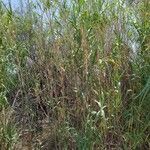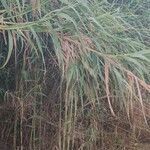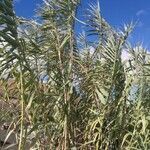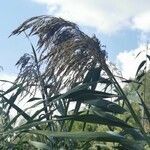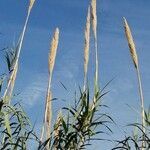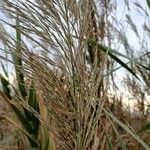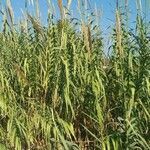Robust reed from a thick knotty rhizome. Culms very stout, erect, 2–6 m tall, 1–1.5 cm in diam., unbranched or with bamboolike clusters of slender branches from nodes. Leaf sheaths longer than internodes, usually glabrous except long pilose at mouth; leaf blades 30–60 × 2–5 cm, margins scabrous, tapering to a slender filiform apex; ligule 0.7–1.5 mm. Panicle 30–60 cm, dense, usually purplish; branches 10–25 cm, ascending. Spikelets 10–15 mm, florets 2–5; glumes narrowly lanceolate, 8–12 mm, 3–5-veined, lower glume acute, upper glume sharply acuminate; lemmas linear-lanceolate, 8–11 mm, 3–7-veined, dorsal hairs 5–6 mm, apex minutely bidentate with 1–2 mm awnlet from sinus, lateral veins also shortly extended; palea 1/2 length of lemma body. Fl. and fr. Oct–Dec.
Robust, rhizomatous, reed-like perennial, up to 3 m high; leaf base collar or auricle large and distinct, clasping culm. Leaf blade 700 x 80 mm, deciduous, base rounded or caudate, apex not sharp; ligule a short fringed membrane. Inflorescence a compact, plumose panicle, 300-600 mm long; mature branches stiff and ascending; lowest branches without silky hairs at base. Spikelet 8-15 mm long, laterally compressed; glumes ± equal, ± as long as spikelet, membranous, 3-5-nerved, awnless. Florets 2-7, bisexual or uppermost floret reduced; lemma 3-9-nerved, back long-hairy, lobes awned; central awn straight, shorter than body of lemma; callus short, blunt, hairy; anther 2.5-3.5 mm long. Flowering time Feb.-Apr.
Reeds. Culms 2–8 m high, often more than 0.5 cm diam., with internodes hollow. Leaves glabrous; blade 5–100 cm long, 20–80 mm wide, with rounded and pale yellow-green auricles. Inflorescences open, with 300–1000 spikelets. Spikelets 10–14 mm long, with 3–5 florets. Glumes similar, equalling florets; lower glume 11–13 mm long, pale, often pink. Lemma 2-lobed, with body 7–8 mm long, villous; lobe setae 1–2 mm long; awn 1–3 mm long. Palea linear to lorate, 4.5–5.5 mm long, villous between keels. Anthers 2.5–3 mm long.
Robust, reed-like perennial, up to 3000 mm high; rhizomatous. Leaf blade 700 x 80 mm, deciduous; base rounded or caudate, collar or auricle large and distinct, clasping the culm; apex not sharp; ligule a short fringed membrane. Inflorescence 300-600 mm long, a compact plumose panicle; mature inflorescence branches stiff and ascending; lowest inflorescence branches without silky hairs at the base. Spikelet 8-15 mm long; glumes as long as spikelet, membranous, awnless; lemma back long hairy; anthers 2.5-3.5 mm long.
Perennial, up to 6 m tall, spreading by means of dense horizontal root-stock. Leaves linear to lanceolate, with large `ear lobes' at base, tips not pungent; ligule a fringed membrane. Inflorescence a large, 300-600 mm long, silky plumose panicle, branches erect/ascending (if leaf `ear lobes' small and inflorescence branches drooping see Phragmites). Spikelets 8-15 mm long; 2-many-flowered; glumes ± equal; lemma long hairy, shortly awned.
Perennial, rhizomatous, up to 3 m high, robust, not tufted. Leaf blades up to 0.7 m long, up to 80 mm wide, leaves deciduous at base of blade, blades rounded or caudate at base, tips not sharp; ligule with fringing hairs shorter than membranous base. Spikelets 8-15 mm long. Inflorescence 0.3-0.6 m long, compact with ascending branches; lemmas with long hairs on back.
A large grass. It grows 3.7-4.5 m tall and 1.2-1.8 m wide. It forms clumps. It has rhizomes. The stems are like bamboo. They can be 6 m tall. The leaves are drooping and grey-green. They are 60 cm long. They have thick joints and slender stems. The flower plumes are feathery and purple at first but white later. They grow on second year stems in mild climates.
Perennial; up to 3 m high; robust; rhizomatous; not tufted. Leaf blades up to 0.7 x 80 mm; rounded or caudate at base; apices not sharp; leaves deciduous at base of blade; ligule with fringing hairs shorter than membranous base. Flowers: panicle compact with ascending branches 0.3-0.6 m long; spikelets 8-15 mm long; lemmas with long hairs on back.
Robust, bamboo-like perennial to 3 m. Leaves lanceolate, deciduous. Spikelets 12-18 mm long, in a large, compact, plumose panicle 30-60 cm long.
